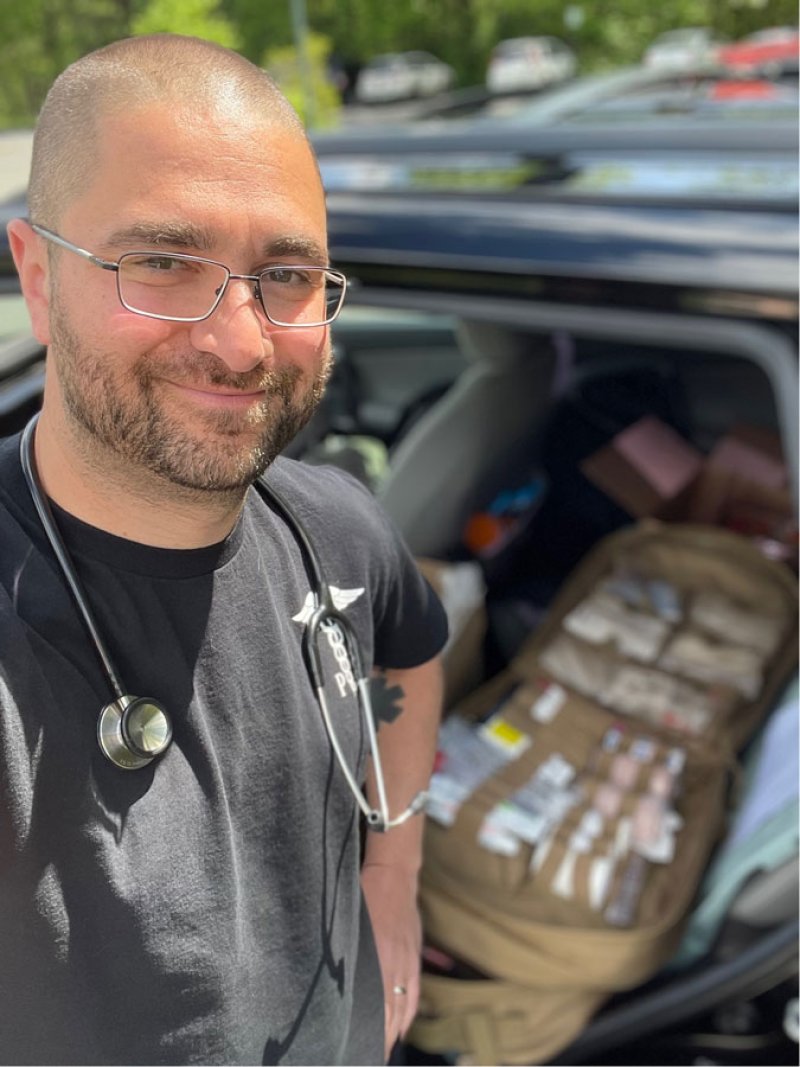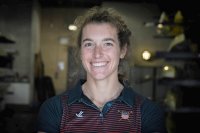SARATOGA SPRINGS —Saratoga Hospital Community Health Center (CHC) physician assistant Samuel Halajian, MPAS, PA-C, traveled a circuitous pathway to his career. Pivoting away from his success in film and TV production, Halajian now renders medical care both in a clinic setting and in the street to those with medical needs, regardless of their ability to pay.
A Briarcliff, New York, native, Halajian, a husband and father at 38, describes his early life as “an artist, always.” But even as a student at New York University, he found himself drawn to train as an emergency medical technician (EMT) and, once certified, he volunteered in Ossining, New York. Soon, despite making a professional mark in visual media, he yearned for more responsibility in medicine and became a paramedic, “physically and emotionally demanding work,” he recalls, in busy urban settings, like the Bronx, where he was exposed to a range of serious and stressful situations and problems, including violence, accidents, and injury.
“I loved it, but it was wearing me down,” says the Ballston Spa resident. “I couldn’t imagine doing it for 30 or 40 years. Then I learned about opportunities as a physician assistant, and it was definitely attractive to me. I knew I wanted to be in medicine, but I didn’t want to spend years and years in medical school. Being a P.A. was the answer.”
A physician assistant (P.A.) is a mid-level health care provider who may diagnose illnesses, develop and manage treatment plans, prescribe medications, and serve as a principal health care provider.
After researching his options, Halajian discovered that one of the best P.A. programs in the United States is through the military. In exchange for his extensive medical education, he committed six years of service after completing the training to the Army Reserves; he has two left to go.
“It’s definitely not ‘free’ schooling,” he points out, adding, “The training was fantastic. The Army program is among the top 10 among about 300 in the United States.” Last year, Halajian was temporarily deployed as an Army medical officer to Eastern Europe.
“I love my work for both the Army and the Saratoga Hospital Community Health Center,” he enthuses, “The people I work with in health care are passionate about what we’re doing.”
Although anyone is welcome to use the Community Health Center, Halajian notes that he works extensively with the homeless population, both in the office and in the field, utilizing his special skills in addiction medicine and mental health.
“I go into motels, into the streets, the parking lots, the woods – where the homeless are, I go,” he says. Halajian explains he is part of “street outreach initiative” that relies on a network of partners, including Captain Community Services (the lead agency), Shelters of Saratoga, The Salvation Army, Healing Springs, and RISE Housing and Support Services. Other involved ar agencies include Veterans & Community Housing Coalition, Inc. and Wellspring, which serves individuals experiencing domestic violence. He is part of a weekly video conference with the network partners.
Halajian’s goal in the field is to establish trust with unhomed individuals via consistent, direct engagement outside the office, including to diagnose and treat acute and chronic medical concerns, including splinting a limb, binding a wound, diagnosing diabetes, COVID-19 testing and much, much more. The job is a perfect fit for Halajian, who is dedicated to working with mental health and addiction issues often found in this population.
“It’s a chicken-and-egg question,” Halajian says. “Do people become homeless because they are alcoholic or have mental illness, or does being homeless lead people to drink?” Either way, he tends to those who are struggling. “There are routine places I go,” he notes, “or I might get a call to check out a location or a specific person. I bridge the gap between the doctor’s office and the emergency department, because that’s often where the homeless end up. However, they may get immediate care and then not follow up once they’re on their own again. With me, there’s trust built over time and they’ll hopefully come to the office for help or see me again in the street. Not all, not everyone I see, obviously, follows up, but I would say I now have more than 20 office patients who are unhomed. The situation is improving.”
He says, “There is much I can do in the field and in the office, write prescriptions, order tests that people need to get into detox programs and expedite the results, interact with a case manager from social services, and more.”
Some homeless people depend on Medicaid or Medicare, acknowledges Halajian, but some, such as those who live in a woods encampment, for example, have commercial insurance through a job. Also, social services, disability insurance, and other supplemental income programs are set up to help fill prescriptions.
“When we combine our inter-agency skills, the care team is very resourceful at getting people what they need with discretionary funds from drug companies, for example,” Halajian points out.
Halajian is quick to point out that there is “no one response or reception” to his presence in the field. “It depends on the individual, or even a mood that can change day to day. But I am not there to judge, I am there to love and help them all.”
Some of the homeless want nothing to do with Halajian and his services, he admits, but he rarely gets “right down to business. We do a little dance of getting to know each other to build trust. Some of these people, when sober, are intelligent, funny, and warm. I love talking to them, whether we’re in the street or the office. More and more, enough of them know who I am to begin to believe I’m there to help. There are folks I encounter who start out very suspicious, people with mental illness, and they’re really challenging to treat, they’re very guarded, but the vast majority are willing to engage and want me to be their provider.”
Halajian observes that there are fluctuations in the volume of the homeless population and that “They seem to come in waves – in the summer there are many homeless near the train station in the woods, but then some end up in jail or in the hospital or another mental health program, and many are gone when it gets cold.”
“Everyone individual is different,” underlines Halajian. “There is not one single factor that drives people into the street; if we talk to 50 people, we get 50 stories. Looking at human beings as ‘trends’ is not useful. What is productive is asking what we can do.”
Halajian disagrees with those who claim there aren’t enough services for people who are unhomed. “We have services, what we also have are barriers to access, for example, a lot of people don’t have transportation to service agencies or doctors and that’s the problem: barriers to care.”
He also says that mental health problems are another barrier, as it may make patients non-compliant. “If I see someone with high cholesterol and treat them, but they insist on living on pizza and hamburgers, that’s not my fault,” he points out. “We can offer assistance, but we can’t make people accept it. But, it’s really important not to paint the homeless population with a broad brush. While a lot of my patients have the tragic disease of alcoholism, we do have some success engaging them for detox, mental health services, and employment. It helps to find out about the individual’s unique history and how he or she got to a place of being homeless and alcoholic, or to abusing other substances, to support them in making good progress. I put my hand out – it’s up to them whether to take it. Sometimes, people with addiction issues make bad choices. Unfortunately, that’s when they become visible to the public. I try to give people the help they need so they can do better, do well.”
Halajian notes that the Community Health Center is a patient-centered medical home which offers behavioral health, addiction medicine, dental, and primary care services.
“This is complex work,” Halajian says. “We have to keep these people safe. Nobody should freeze to death in Saratoga - I think we can all agree on that. People get uncomfortable and unhappy with the idea of unhomed people being around them, so I’m grateful that my role is focusing on health care, but I can’t do it all by myself. That’s why we have a network of partners. We are there for each other and the people we serve. I get to build all these relationships with people who live with barriers. I get to talk to people about how to take care of themselves – and that’s a privilege. There’s a lot on my plate, but it makes me grateful to have a home, food on my table, and a family to love.”
_______________________
The Coronavirus Aid, Relief, and Economic Security Act, also known as the CARES Act, is a $2.2 trillion economic stimulus bill that became law on March 27, 2020, in response to the economic fallout of the COVID-19 pandemic in the United States.
The CARES Act appropriated $4 billion through the Emergency Solutions Grant (ESG) Program to prevent, prepare for, and respond to coronavirus among individuals and families who are homeless, or receiving homeless assistance, and to support additional homeless assistance and homelessness prevention activities to mitigate the impacts created by coronavirus under the ESG program.
P.A. Samuel Halajian’s time working out of the office with the homeless is supported by these programs.
Benefits to street outreach program:
• Reduction in emergency department and urgent care utilization.
• Reduction in fire department/emergency medical services utilization.
• Stabilization of medical problems.
• Engagement in case management.
• Housing and job placement.
• Diminished panhandling and vagrancy.
• Improved economic health for the city.
• Number of patients that have established relationships with the Community Health Center: 22
• Number of patients referred to CHC behavioral health or addiction medicine: 14
• Average number of patient contacts per month: 48



























 How to resolve AdBlock issue?
How to resolve AdBlock issue? 









